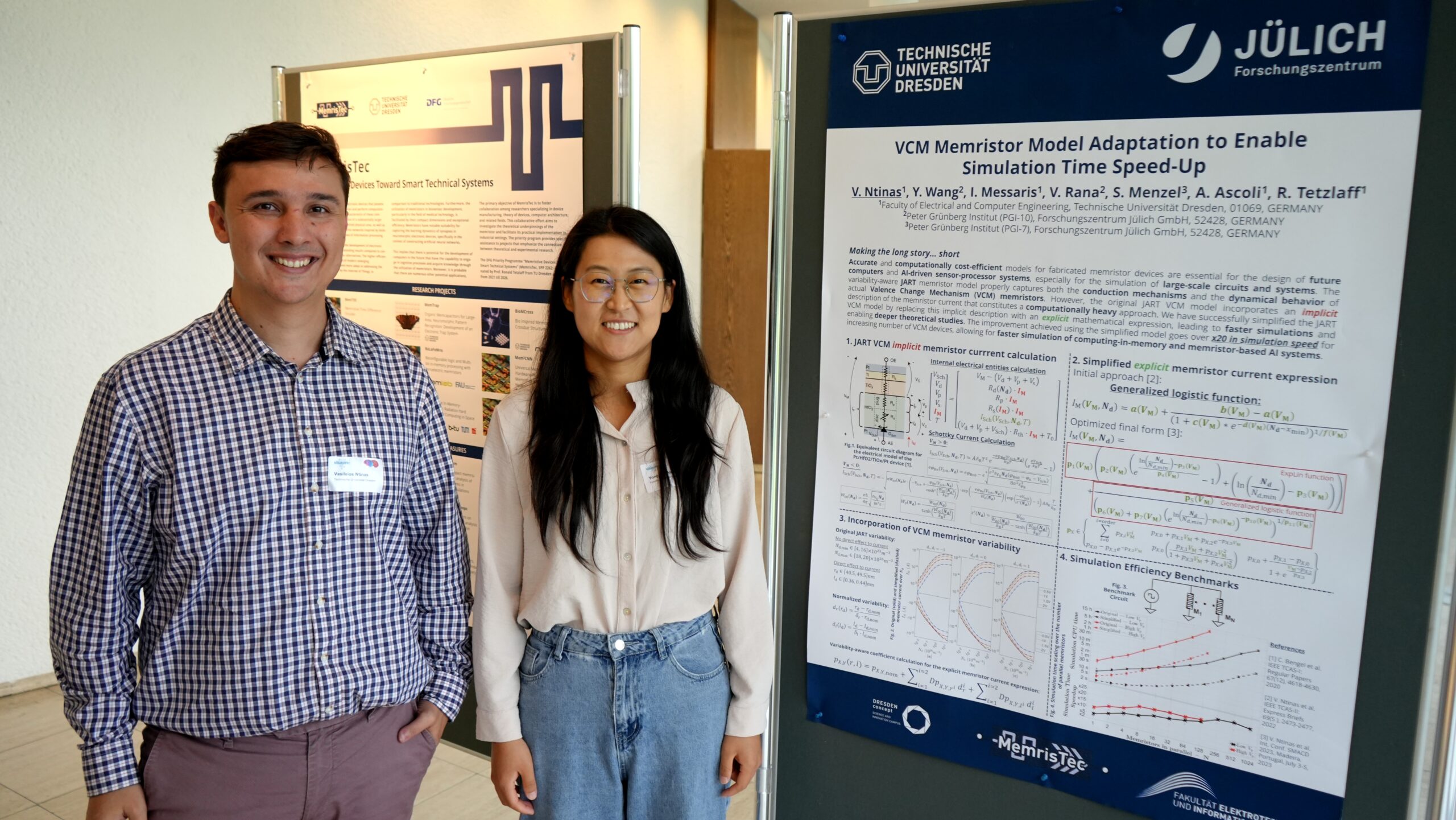Yongmin Wang, Kristoffer Schnieders, Vasileios Ntinas, Alon Ascoli, Felix Cüppers, Susanne Hoffmann-Eifert
IEEE Transactions on Nanotechnology ( Volume: 24), 24 February 2025
Yongmin Wang, Kristoffer Schnieders, Vasileios Ntinas, Alon Ascoli, Felix Cüppers, Susanne Hoffmann-Eifert
IEEE Transactions on Nanotechnology ( Volume: 24), 24 February 2025
Amir Khan, Vasileios Ntinas, Jorge Fernandez-Berni, Ricardo Carmona-Galan, Ronald Tetzlafft
31st IEEE International Conference on Electronics, Circuits and Systems (ICECS), 18-20 November 2024
Nicolas Schmitt, Ioannis Messaris, Ahmet Samil Demirkol, Vasileios Ntinas, Dimitris Prousalis, Ronald Tetzlaff
2024 IEEE International Conference on Metrology for eXtended Reality, Artificial Intelligence and Neural Engineering (MetroXRAINE), 21-23 October 2024
Nicolas Schmitt, Alon Ascoli, Ioannis Messaris, Ahmet Samil Demirkol, Stephan Menzel, Vikas Rana, Ronald Tetzlaff, Leon O. Chua
Nicolas Schmitt, Alon Ascoli, Ioannis Messaris, Ahmet Samil Demirkol, Vasileios Ntinas, Dimitris Prousalis, Spyridon Nikolaidis, Ronald Tetzlaff, Stephan Menzel, Vikas Rana
12th International Conference on Modern Circuits and Systems Technologies (MOCAST), 28-30 June 2023
Yongmin Wang; Vasileios Ntinas; Alon Ascoli; Ioannis Messaris; Ronald Tetzlaff; Vikas Rana; Stephan Menzel
6th International Conference on Memristive Materials, Devices & Systems (MEMRISYS 2023), 5-9 November 2023
Vasileios Ntinas; Yongmin Wang; Ioannis Messaris; Vikas Rana; Stephan Menzel; Alon Ascoli; Ronald Tetzlaff
6th International Conference on Memristive Materials, Devices & Systems (MEMRISYS 2023), 5-9 November 2023
On 30.08.2023 the Mem²CNN team presented results at the Neuromorphic Computing Days at FZ Jülich, Germany.

Vasileios Ntinas; Dharmik Patel; Yongmin Wang; Ioannis Messaris; Vikas Rana; Stephan Menzel; Alon Ascoli; Ronald Tetzlaff
2023 Int. Conf. on Synthesis, Modeling, Analysis and Simulation Methods and Applications to Circuit Design (SMACD), 03-05 July 2023
Ioannis Messaris, Alon Ascoli, Dimitrios Prousalis, Vasileios Ntinas, Ahmet Samil Demirkol, Ronald Tetzlaff
2023 Int. Conf. on Synthesis, Modeling, Analysis and Simulation Methods and Applications to Circuit Design (SMACD), 03-05 July 2023
Nicolas Schmitt; Alon Ascoli; Ioannis Messaris; Ahmet Samil Demirkol; Vasileios Ntinas; Dimitrios Prousalis; Ronald Tetzlaff; Spyridon Nikolaidis; Stephan Menzel; Vikas Rana
12th International Conference on Modern Circuits and Systems Technologies (MOCAST), Athens, Greece, 28-30 June 2023
Yongmin Wang; Alon Ascoli; Ronald Tetzlaff; Vikas Rana; Stephan Menzel
2022 IEEE International Symposium on Circuits and Systems (ISCAS), 27 May 2022 - 01 June 2022, Austin, TX, USA
Vasileios Ntinas; Alon Ascoli; Ioannis Messaris; Yongmin Wang; Vikas Rana; Stephan Menzel; Ronald Tetzlaff
IEEE Transactions on Circuits and Systems II: Express Briefs (Volume: 69, Issue: 5), 17 March 2022
Alon Ascoli, Stephan Menzel, Vikas Rana, Tim Kempen, Ioannis Messaris, Ahmet Samil Demirkol, Michael Schulten, Anne Siemon, Ronald Tetzlaff
Advanced Electronic Materials, 11 August 2022
Alon Ascoli, Ronald Tetzlaff; Vikas Rana; Stephan Menzel
2021 28th IEEE International Conference on Electronics, Circuits, and Systems (ICECS), 28 November 2021 - 01 December 2021, Dubai, United Arab Emirates
In state-of-the-art von-Neumann computing architectures, the central processing unit (CPU) and the memory are physically separated and communicate only via a finite-bandwidth data bus. In the Internet-of-Things and Big Data processing era, however, the data transfer becomes the limiting factor in computing performance. This limitation, also called the von-Neumann bottleneck, poses a serious constraint for novel popular applications requiring a great deal of data transfer. Thus, the research community is exploring new computing paradigms, in which memory and processing unit are integrated one onto the other.
One promising approach is based on the Cellular Nonlinear Network (CNN) computing paradigm. A single CNN cell consists of a capacitance, a resistance, and a number of voltage-controlled current sources. The cells are organized in a 2D or 3D grid, in which only neighboring cells are physically coupled. The network performs different computation tasks on the basis of the coupling and self-coupling arrangements. Back in 1993, T. Roska proposed to add local storage units to each CNN cell to realize a Universal Machine (UM), the first ever demonstration of a non-von Neumann computer.
CNN cells have been implemented in hardware in combination with photodetectors for the development of very efficient visual microprocessors. The integration of memory units into each cell, however, consumes a large space, and, finally, leads to the poor spatial resolution CNN-based vision sensors suffer from. In order to overcome this issue, very simple non-volatile memory elements with high scalability are required. Memristive devices, especially based on redox mechanisms, show such properties and, thus, they could be the ideal technology candidate to resolve the area-based performance limitation of state-of-the-art CNN-UMs.So far, CNN-UMs have been analyzed only on a theoretical and simulation domain, while a verification in hardware is still missing.
In the proposed Mem2CNN project, the feasibility of Memristor CNN-UM (MCNN-UM) is explored. To this end, the group at TU Dresden teams up with the group at FZ Jülich, combining expertise on memristor and CNN theory (TU Dresden), and on memristor fabrication and physical modeling of memristive devices (FZJ). In the project, the physical compact models of FZJ will be reformulated to enable a more fundamental theoretical framework for memristive circuit modeling and investigation. Moreover, single M-CNN cells will be fabricated and characterized for the first time. For this purpose, a small hardware demonstrator, consisting of a matrix of 6×6 MCNN cells, will be showcased to demonstrate the execution of various tasks, such as the extraction of corners or edges from an input image. Based on the theoretical framework for MCNNs, larger networks will be designed and simulated to demonstrate the potential for computation universality, versatility, and efficiency of the MCNN-UM memcomputing approach.

